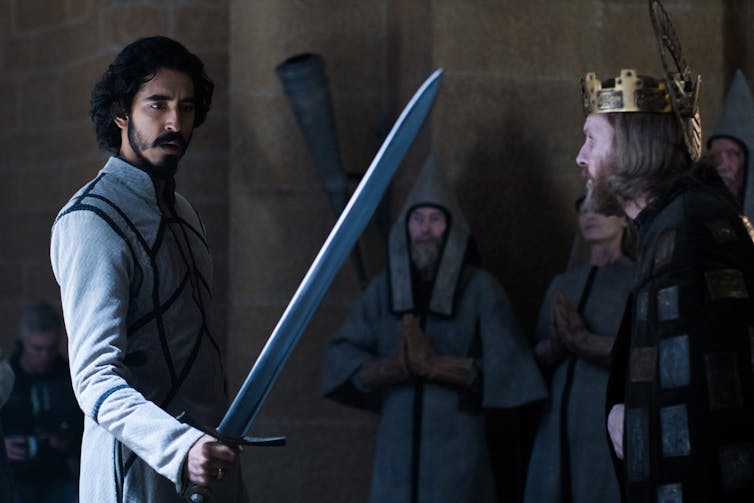By Sabina Rahman, Macquarie University
Review: The Green Knight, directed by David Lowery.
Nothing about The Green Knight, the new film from director David Lowery, is comfortable.
From its opening scene, where Gawain (Dev Patel) sits in an empty throne room, a crown menacingly hovering above his head as flames suddenly engulf him, this film is wonderfully unsettling.
The Green Knight is a reimagining of the Middle English poem Sir Gawain and the Green Knight, which tells the story of Gawain, a knight of King Arthur’s court. Gawain accepts a challenge from a supernatural Green Knight (Ralph Ineson) to use his axe to strike this knight, and take a reciprocating blow from him the following Christmas.
Although Gawain beheads his opponent, the Green Knight does not die. When Gawain departs the following year to fulfil his promise, he demonstrates chivalry and fidelity to duty. But despite this show of chivalry, his honour is tested by the lord and the lady of the Hautdesert, a castle in which he takes refuge.
This narrative poem is a part of the larger collection of stories about King Arthur: a pseudo-history caught up in ideas about nationhood and identity. Throughout this tradition, Arthur is posited as a “once and future king”; Camelot as a utopian government. https://www.youtube.com/embed/I_GhSLFFGaQ?wmode=transparent&start=0
Today, representations of the Middle Ages have been embraced by right-wing nationalists. But Lowery’s adaptation disrupts these narratives of a utopian past and future.
Lowery presents a series of contradictions and conflicts between duty, heroism, honour, fear and temptation. He offers viewers a medieval world in which contemporary anxieties about nationality, national identity and personal politics can be explored.
The hero’s journey
Despite being named for the monstrous Green Knight, this film follows the story of Gawain, the nephew of King Arthur (Sean Harris).
Awed by the King’s invitation to sit with him, Gawain quietly contends the other knights present “have spilled enough blood” to be more deserving of the honour.
Read more: Disney’s Mulan tells women to know their place
But despite his inexperience, Gawain is the first to meet the challenge of the eponymous knight: to strike him and receive the same blow in return the following year. Although Gawain severs the knight’s head with one clean blow, he retrieves his gruesome head, his raspy laughter echoing off the walls.
Unlike the knightly figure in the medieval poem, Patel’s Gawain is not yet a knight. The bulk of this film forms his hero’s journey: his chance to spill blood for his King and be worthy of a seat at the table.

Gawain was a celebrity as he left Camelot. The hero of street theatre productions and the subject of portraits; a popular culture icon recognised by all. But his bravery had been untested.
Indeed, the chivalric bravery expected of a legendary knight is remarkably absent during this journey. This Gawain displays weakness, uncertainty and fear.
He cites “honour” as the motivation for his journey. Yet the Gawain of this film asks the restless spirit of a raped and murdered woman for payment to retrieve her head so that she may be at peace. He succumbs to the sexual advances of the lady of the house in which he is given refuge. He would use an enchanted girdle to trick his way out of his knightly duty.
Honour does not seem to be one of his virtues.
Read more: The more video streaming services we get, the more we’ll turn to piracy
De-romanticising the medieval
This disparity between the celebrated hero of medieval legend and the flawed Gawain of this film invites us to consider how the medieval is reconstructed in popular culture.
The Green Knight begins in a conquered land. When Gawain rides to the Green Chapel, the signs of war are all around him, from the stark landscape pocked with ruin to an entire battlefield of recently dead men.
These are the Saxons the King is referring to when he gives his Christmas speech:
Out my window this morn, I looked and I saw a land shaped by your hands. You have lain those same hands on your Saxon brethren, who now in your shadow bow their heads like babes. Peace. Peace you brought to your kingdom.
The peace was won through a bloody conquest, but our contemporary imagining of a medieval past often romanticises these conquests. This sort of romanticisation encourages the use of the medieval in right-wing politics, and can legitimise racism.
This film interrupts those narratives not just with the colour-conscious casting of Gawain and his mother Morgana (Sarita Choudhury), but also with its demand that we look beyond the common plot points of medievalist stories into what lies beneath: the conquests, the displacement of people, the grotesque Middle Ages.

Patel’s performance as Gawain is nothing short of captivating. Doubt, vulnerability and trepidation pour from him throughout the quest.
Lowery’s film is beautifully cast and beautifully shot, but always disquieting and inquisitive. It leaves the viewer with more questions than answers.
From the lilting, hissing, ominous voice over of the opening scene, The Green Knight will enthral you – right through to the ambiguous ending where you will release a breath you did not even know you were holding.
The Green Knight is on Amazon Prime from 28 October.
Sabina Rahman, Sessional Academic in English Literature, Macquarie University
This article is republished from The Conversation under a Creative Commons license. Read the original article.





